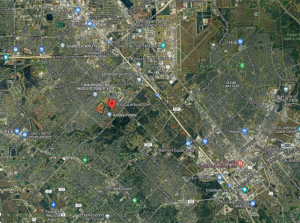New Federal Funding Opens Up New Opportunities for Brownfield Reclamation Projects

Vacant land in metropolitan Houston, Texas, is hard to come by – and the open area close to the Gulf Freeway would make an ideal site for development.
New economic opportunities opened up for Brownfield remediation with a $1.2 billion funding boost from the Bipartisan Infrastructure law.
When you are shopping for a new house, it’s not unusual to drive for miles exploring neighborhoods. But developers looking to build large projects often take to the air to scout out large parcels suitable for development. Such was the case with Walt Disney, who took flight over central Florida in 1963 – spying thousands of acres of undeveloped swampland close to new highways south of Orlando.
Today, we have the advantage of satellite imagery, which makes site selection much more convenient – however, you may have noticed that some of the most promising vacant real estate parcels – e.g., those near cities or located on navigable waterways – may be vacant for an important reason: they are brownfields contaminated with pollution, unable to be developed without significant remediation.
There is renewed interest in remediating brownfield sites, both from an economic and a health benefits point of view. Due to the way our cities and industries have developed over the last 100-plus years, many of these sites are sitting in prime real estate locations.
Many polluted industrial sites that were once far from city centers when they were built are now considered to be in the heart of metro areas as cities have grown around them. Other industrial sites were built on what are today considered prime waterfront sites – not because they were scenic and desirable but because they offered direct access to water power (such as rivers or dams) or navigable waters and industrial canals used to transport goods by ships or barges.
Depending on the individual circumstances, the presence of brownfields in a community can be a serious, long-term health hazard, a drag on economic development and city planning, or both.
It’s for these reasons (and more) that the Biden administration has promoted and passed new funding to help remediate more contaminated brownfield sites, allowing them to become economic assets for the surrounding communities.
Brownfields, Greenfields, Greyfields, And The Superfund National Priority List (NPL)
Let’s take a moment to review some definitions.
In this article, we are going to focus on brownfields, which are generally defined as having been compromised through past industrial use, generally due to significant pollution or contamination left behind that has penetrated the ground or even entered the water table.
This is in contrast to greyfields, the term urban planners use to describe otherwise uncontaminated sites with structures that could be torn down, redeveloped, or repurposed to create a better economic return (aka a “highest and best use”) – or greenlands, which are virgin vacant lands which have not seen major industrial development in the past and are ready for immediate development.
In the 1970s, two highly publicized cases of industrial pollution, the Love Canal subdivision outside Buffalo, New York, and a field where drums of chemicals had been dumped (known as the “Valley of the Drums”) outside of Louisville, Kentucky, helped galvanize public opinion that something needed to be done to remediate dangerous brownfield sites.
In response, Congress passed the Comprehensive Environmental Response, Compensation, and Liability Act of 1980 (CERCLA) –commonly known as the Superfund law, which documents contaminated brownfield sites and oversees their remediation.
The CERCLA legislation stipulated, where possible, that polluters pay for the remediation; however, in many cases, it has proven difficult to track down “potentially responsible parties” (PRPs) due to poor historical records or the companies responsible having ceased operations or fallen into bankruptcy.
The EPA was put in charge of maintaining a list of Superfund sites (currently around 40,000 nationally) as well as investigating which sites should be remediated first. The EPA’s National Priorities List (NPL) has ranked the worst of 1,333 contaminated sites.
How are the sites prioritized? State agencies and the EPA rely on the Hazard Ranking System (HRS), a zero to 100 scale that quantifies how much of a risk that hazardous chemicals pose at each Superfund site, to identify and rank the worst sites for remediation projects.
Read more...
Julia Solodovnikova
Formaspace
+1 800-251-1505
email us here
Visit us on social media:
Facebook
Twitter
LinkedIn
Legal Disclaimer:
EIN Presswire provides this news content "as is" without warranty of any kind. We do not accept any responsibility or liability for the accuracy, content, images, videos, licenses, completeness, legality, or reliability of the information contained in this article. If you have any complaints or copyright issues related to this article, kindly contact the author above.


